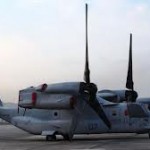Washington Post | By Associated Press
 WASHINGTON — A Marine Corps investigation has concluded that operator error caused the deadly April crash of an MV-22 Osprey aircraft in Morocco — an incident that has fueled unease in Japan, where the hybrid aircraft are being deployed.
WASHINGTON — A Marine Corps investigation has concluded that operator error caused the deadly April crash of an MV-22 Osprey aircraft in Morocco — an incident that has fueled unease in Japan, where the hybrid aircraft are being deployed.
In a report obtained Thursday by The Associated Press, the Marine Corps ruled out mechanical and safety problems with the tilt-rotor Osprey, which takes off like a helicopter and flies like an airplane. The report said high winds and failure to follow proper flight procedures were two significant factors in the crash.
Two Marines were killed and two others severely injured when the Osprey crashed during a training exercise in Morocco. The investigation found that there was no misconduct or intentional neglect on the part of the Marines.
Japanese officials have raised concerns about the safety of the Osprey after the Morocco incident and a June crash of an Air Force Osprey in the Florida Panhandle that injured five airmen. The first 12 Ospreys have arrived in Japan.
Defense Secretary Leon Panetta has defended the use of the aircraft in Japan, saying it will allow the Marines there to fly faster and farther to remote islands in the region. The Osprey also can refuel in flight.
Panetta also has said the U.S. will delay Osprey flight operations in Japan until the government there agrees that the aircraft is safe.
The Marine investigative report, which will be released Friday, also recommended safety changes for Osprey crew members who usually ride in the aircraft secured only by a belt attached to a long tether. The two crew chiefs who died in the Morocco crash were both attached to such tethers, rather than strapped into seats. The pilot and co-pilot were strapped into their seats and survived even though the Osprey crashed nose first.
“A major push must be made in the rotary wing community,” the report said, “for all crew members to be strapped to their seats when not performing some critical function.”
Often, particularly during combat flights, crew members watch out the back of the aircraft and can move around, secured only by the belt, which is hooked to a tether line that is attached to the aircraft.
While the report said there is no guarantee that the two crew chiefs would have lived if they’d been strapped into seats, the report said studies show that safety seats increase the chance of survival.
According to the report, the Osprey was taking off into a heavy headwind and, in an effort to avoid flying over some tents that were set up for the exercise, the co-pilot made a 180 degree turn, lost control and crashed from a height of about 46 feet. The report said that “lack of understanding of the true wind speed” was a factor in the crash.
The investigation also recommended that the flight field manuals be updated to include more detailed information about how to best transition from the helicopter-like take off to the regular aircraft flight when there is a tail wind.
The Osprey is built by the Bell Boeing team, an alliance between The Boeing Co. and Bell Helicopter-Textron.
___
Follow Lolita C. Baldor on Twitter: http://twitter.com/lbaldor







